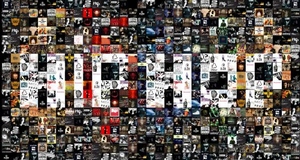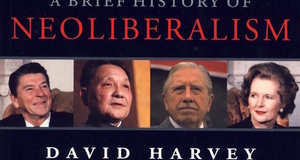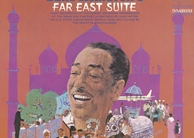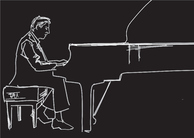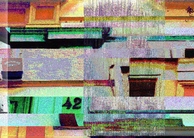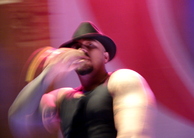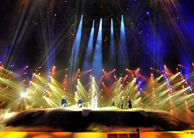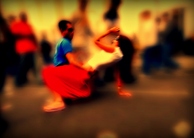Innovation or Desperation: David Bowie's "Little Wonder"
By
2010, Vol. 2 No. 02 | pg. 2/2 | « Bowie expands on this idea between 2:07 through 2:13. Here, the same material that has been presented since 1:40 is repeated, but this time there is an ethereal and relatively lyric melody threading through the texture. This melody is in a back-up vocal that is treated through either a synthesizer or a particular microphone. Once again, Bowie is taking a “natural” element and making it into a technological one. The inverse is also true between 2:34 and 2:36. Here, a descending triad can be heard in the steam whistle sample that has become a part of the sonic fabric. A technological element has been used to create a “natural” musical phenomenon11. Most pop and rock songs have some sort of instrumental solo that acts as a bridge to the final statement of the piece. “Little Wonder” is no exception. 2:57 to 4:12 contains this solo, which also happens to be the longest segment of the track. What is so unique about this solo is that the featured instruments are the synthesizer and the sample. For a minute and fifteen seconds (which is almost 20% of the entire track), a variety of synthesized sounds from distorted vocals and guitar licks to drum loops and “industrial” sound recreations dominate. It is in the use of the “computer” as a solo instrument that Bowie makes his view of techno music and rave culture known. He sees the whole scene as a compositional tool, as an effect and a style to be woven into a larger whole rather than an end goal in and of itself. In many ways, “Little Wonder” and the album to which it belongs are more a return to David Bowie’s roots than it is something new. Just as he did almost thirty years before in the “Glitter and Blood” era, he brought an underground, youth movement to the realm of the mainstream and, in some of the album’s tracks, the avant-garde. He does that by using elements of a sound or movement to create something all his own and express his own musical and artistic point of view rather than becoming just another generator of a moment’s sonic identity.In this album, David Bowie achieved a new level of the iconic status he had reached in the 70s. Only, now, he did not have to be Ziggy Stardust or Aladdin Sane or any other alter ego to do it. David Bowie himself is all the alter ego he needs. LyricsLittle Wonder David Bowie experiments with writing lyrics using websites with cut and paste generators. It seems that that technique was used here as well. Notice that the names of all seven dwarves appear in these lyrics. That was, indeed, intentional. ReferencesAlexander, Mike. “Bowie Flies Again.” The Dominion [1997] http://www.teenagewildlife.com/Reviews/Albums/E/NZDominion.html. [accessed December 3, 2007]. Bailey, Russell. “David Bowie, Earthling (Arista)” New Zealand Herald. [1997]. http://www.teenagewildlife.com/Reviews/Albums/E/970222_NZHerald.html. [accessed December 3, 2007]. Belcher, David. “Earthling: David Bowie.” http://www.teenagewildlife.com/Reviews/Albums/E/DavidBelcher.html. [accessed December 3, 2007]. Bell, Max. “The Golden Years.” Classic Rock, November, 2007. Bennett, James. “Earthling: David Bowie.” Telegraph Group Limited. [1997]. http://www.teenagewildlife.com/Reviews/Albums/E/DailyTelegraph970201.html. [accessed December 3, 2007]. Bowie, Angie, Herbie Flowers, Woody Woodmansey. David Bowie: Music in Review. Interviews by Rachel Griffiths and Gary Moore. England: Edgehill Pubishing Ltd, 1988. Bowie, Angie, Herbie Flowers, Woody Woodmansey. David Bowie: Music in Review. Interviews by Rachel Griffiths and Gary Moore. DVD. Ragnarock Films, Ltd, 2003. Considine, J.D., “Welcome Back, Mr Bowie.” [sic] the Sunday Star. [1997]. http://www.teenagewildlife.com/Reviews/Albums/E/NZSundayStar.html. [accessed December 3, 2007]. David Bowie, interview by Bill DeMain. In Their Own Words: Songwriters Talk About the Creative Process. Westport, CT: Preager, 2004. Drenth, Philip. “Little Wonder.” Stardust: The Unabashed David Bowie Music Guide. http://phil.cts.com/bowielps.html. [accessed December 4, 2007]. Farber, Jim. “Greetings, Earthling.” Entertainment Weekly. [1997]. http://www.teenagewildlife.com/Reviews/Albums/E/EntertainmentWeekly.html. [accessed December 6, 2007]. Gaillot, Michel. Multiple Meaning Techno: An Artistic and Political Laboratory of the Present. Translated by Warren Niesluchowski. Paris: Éditions Dis Voir, 1999. Goodwin, Suzanne. “Earthling: David Bowie Virgin Records.” Drop-D [April 4, 1997]. http://dropd.com/issue/50/CD/DavidBowie/. [accessed November 2, 2007]. Kemp, Mark. “David Bowie: Earthling.” http://www.rollingstone.com/artists/dabidbowie/albums/album/219450/review/594288/earthling. January 24, 1997. [accessed November 2, 2001]. Peel, Ian. “Rave.” Grove Music Online. Oxford University Press, 2007. http://grovemusic.com/shared/views/article.html?section=music.47226. (Accessed 27 November 2007). Reynolds, Simon. Energy Flash: A Journey through Rave Music and Dance Culture. London: Picador, 1998. Reynolds, Simon. Generation Ecstasy: into the world of techno and rave culture. Boston: Little Brown and Company, 1998. Sheffield, Rob. “Earthling.” Details. [March 1997]. http://www.teenagewildlife.com/Reviews/Albums/E/Details.html. [Accessed December 5, 2007]. Torrie, Evan. “Earthling-The Album.” Teenage Wildlife. http://www.teenagewildlife.com/Albums/E/Title.html. [accessed December 5, 2007]. Zak, Alban III. “Tracks.” In The Poetics of Rock: Cutting Tracks, Making Record. Berkeley, Los Angeles: University of California Press, 2001. Endnotes1.) In 1997, David Bowie was fifty years old, an age that seems to carry a certain stigma for pop recording artists. 2.) Bowie’s willingness to make a album inspired by a passing movement was viewed as a dramatic decline from the 1970s, in which he was the founder of movements in the public consciousness. 3.) All drum loops and other percussion is the work of Zachary Alford. 4.) This is almost the opposite of the electric guitar sound which was characterized by long sustain of tone and a short decay. 5.) Please see lyrics, above. 6.) I am unsure if this is a second vocalist, a layering of two Bowie vocals, or an intentional echo effect of the recording. 7.) It is present underneath the guitars of the first measure of this section, but it is not as audible through that texture as it is under the whistle sample. 8.) This means that it likely came from the synthesizer on which the original drum loop was made. 9.) Which is still the work of Zachary Alford. 10.) These added vocalists are real and synthesized guitarist Reeves Gabrels and electric bassist Gail Ann Dorsey. 11.) This differs from the ascending triad of the piece’s introduction in that the introduction contained a synthesized guitar, which is at least relates to a standard musical instrument designed to make pitch in this way. Suggested Reading from Inquiries Journal
Inquiries Journal provides undergraduate and graduate students around the world a platform for the wide dissemination of academic work over a range of core disciplines. Representing the work of students from hundreds of institutions around the globe, Inquiries Journal's large database of academic articles is completely free. Learn more | Blog | Submit Latest in Music |








